
The Role of 3D Printing in Modern Enclosure Manufacturing
Share
Have you ever wondered how modern enclosures are manufactured with such precision and efficiency? The answer lies in the innovative technology of 3D printing. This cutting-edge process has revolutionized the way enclosures are designed, prototyped, and produced. Let's delve into the role of 3D printing in modern enclosure manufacturing.
What is 3D Printing?
3D printing, also known as additive manufacturing, is a process of creating three-dimensional objects by layering materials based on a digital model. This technology allows for the production of complex and customized designs that traditional manufacturing methods may struggle to achieve.
How Does 3D Printing Benefit Enclosure Manufacturing?
3D printing offers a myriad of benefits for enclosure manufacturing. One of the key advantages is the ability to rapidly prototype designs, allowing for quick iterations and improvements. This agility in the design phase results in faster time-to-market for new enclosure products.
Additionally, 3D printing enables the production of intricate geometries and lightweight structures that are both durable and functional. This level of design freedom opens up new possibilities for creating innovative enclosure solutions that meet specific requirements.
What Materials are Used in 3D Printing Enclosures?
Various materials can be used in 3D printing enclosures, depending on the desired properties and applications. Common materials include thermoplastics like PLA, PTEG, ABS and ASA, which offer a good balance of strength and affordability. For more specialized applications, materials such as nylon, carbon fiber, and metal powders can be used to achieve specific performance characteristics.
How is 3D Printing Impacting the Future of Enclosure Manufacturing?
The role of 3D printing in modern enclosure manufacturing is only expected to grow in the future. As the technology continues to advance, we can anticipate even greater efficiency, cost-effectiveness, and design flexibility in the production of enclosures. This means that companies will be able to bring innovative products to market faster and more competitively than ever before.
In conclusion, 3D printing has become a game-changer in the world of enclosure manufacturing. Its ability to streamline the design process, create complex geometries, and utilize a variety of materials makes it an indispensable tool for modern manufacturers. As technology evolves, we can look forward to even more exciting developments in the realm of 3D printed enclosures.
